#cryptobiotic soil
Explore tagged Tumblr posts
Text
Excerpt from this story from Smithsonian Magazine:
Under the dry, piercing heat of the Utah sun, Sasha Reed is growing plots of plants—and bacteria, lichen and fungi, too. But Reed is no farmer, and at first glance, her fields look to be mostly dirt. She’s an ecologist, and what she is growing is cryptobiotic soil.
Also called biocrust, cryptobiotic soil is a community of tiny, dirt-dwelling organisms that form a distinct crust on the top of soil in arid landscapes. These crusts are vital across Earth’s dryland ecosystems, helping to hold loose soil together and prevent erosion. They retain water, provide nooks for other microbes to live in and add nitrogen to the soil.
Cryptobiotic soil often looks like a discolored patch of ground. Upon closer inspection, the stain becomes a mosaic of small, dark lumps, dotted with tiny beds of moss and inconspicuous patches of lichen. But it can also look very similar to regular, crusty soil. Although the crunchy earth might be tempting to trek over, like stomping through a pile of crisp autumn leaves, that’s a major faux pas: Biocrust can take decades to regenerate.
And these days, in addition to getting crushed by boots, biocrusts are threatened by another kind of human footprint: climate change. So researchers are diligently working to learn more about the crusts and how to restore them.
“It’s been a pretty busy but also exciting time, because we’re kind of inventing how to do this,” says Anita Antoninka, a plant and soil ecologist at Northern Arizona University in Flagstaff who studies the crusts.
The drylands where biocrusts reside are vital ecosystems, she says, but they are some of the most degraded around the globe. As biocrusts decline in these areas, soil fertility will drop, and wind erosion will blow away the loose, unprotected dirt. Less water will soak into the ground. Even the carbon cycle could be affected, as there will be fewer tiny life forms absorbing carbon dioxide.
Biocrusts cover around 12 percent of Earth’s land surfaces and inhabit every continent in the world. A major component of these crusts is often photosynthesizing bacteria called cyanobacteria. The cyanobacteria form sticky filaments that act like glue in sandy desert soil, creating a clumpy, crusty surface where fungi and other bacteria take hold.
20 notes
·
View notes
Text
calling the desert a "barren wasteland" or "devoid of life" does suuuuch a disservice to the rich ecosystems that exist in the desert
2 notes
·
View notes
Photo

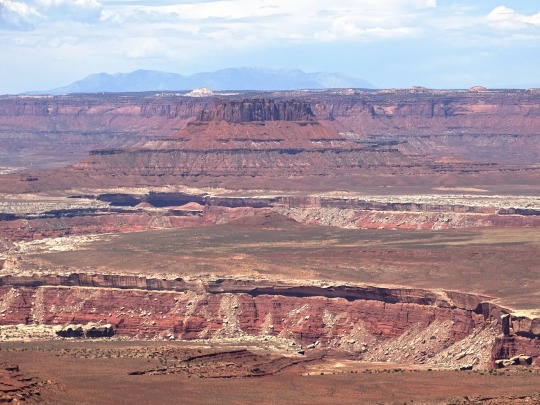
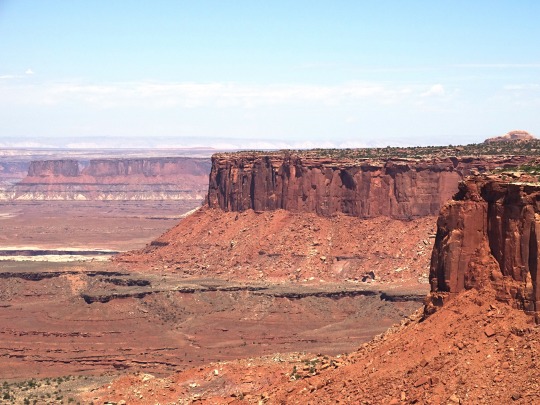
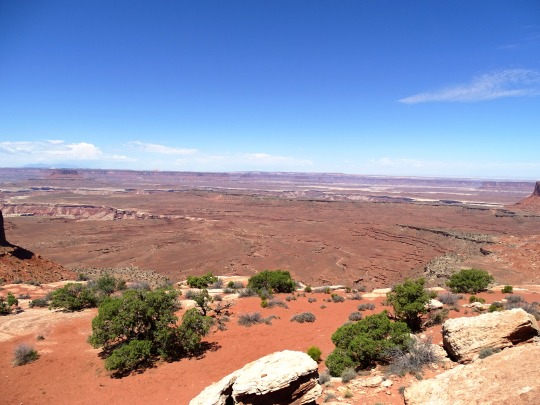


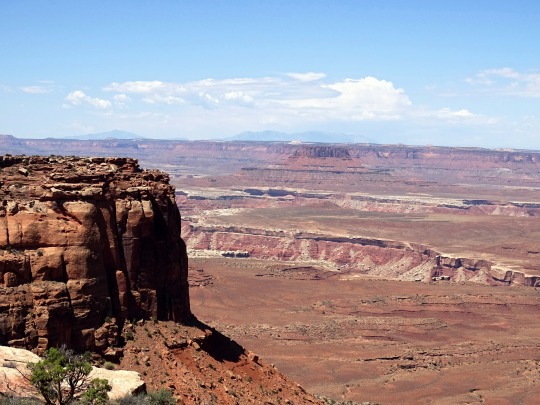

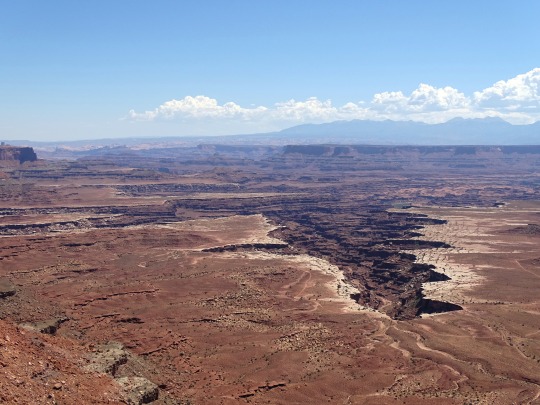
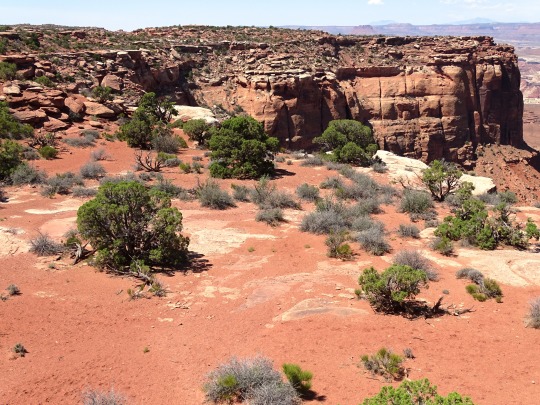
Buck Canyon Overlook, Canyonlands National Park (No. 4)
Canyonlands National Park contains a wide variety of plant life, including 11 cactus species, 20 moss species, liverworts, grasses and wildflowers. Varieties of trees include netleaf hackberry, Russian olive, Utah juniper, pinyon pine, tamarisk and Fremont's cottonwood. Shrubs include Mormon tea, blackbrush, four-wing saltbush and cliffrose.
Cryptobiotic soil is the foundation of life in Canyonlands, providing nitrogen fixation and moisture for plant seeds. One footprint can destroy decades of growth.
Source: Wikipedia
#Buck Canyon Overlook#Canyonlands National Park#desert#geology#bush#grass#flora#nature#landscape#countryside#tourist attraction#landmark#Colorado Plateau#Island in the Sky#original photography#summer 2022#USA#Utah#Western USA#red rock#rock formation#red sand#view#blue sky#clouds#butte#mesa#cliff
97 notes
·
View notes
Text
Although it may just look like dirt, biological soil crusts are full of living organisms like lichens, mosses, algae, micro fungi, and bacteria. In the high deserts of the Colorado Plateau (which includes parts of Utah, Arizona, Colorado, and New Mexico), biological soils may represent 70 to 80 percent of the living ground cover!
Biological soil crusts are found throughout the world and play important roles in their ecosystems. They are sometimes called biocrusts, or, our favorite, cryptobiotic soils— where “crypto” means hidden, while “biota” means life. They are just what their name suggests, hidden life—a living soil that creates a crust over the landscape. These crusts are made up of micro-fungi, soil lichens, mosses, green algae, bacteria, and cyanobacteria. You can find these intricate living communities in the top few millimeters of the soil.
In dry regions, these living soil crusts are dominated by cyanobacteria, some of the oldest known life forms on the planet. Cyanobacteria is dormant when dry. When wet, cyanobacteria become active, moving through the soil and leaving a trail of sticky material behind. This sticks to surfaces such as rock or soil particles, forming an intricate web of fibers throughout the soil. In this way, loose soil particles are joined together, and an otherwise unstable surface becomes very resistant to both wind and water erosion.

Old-growth soil crust at Arches National Park, draped in lichens.
2 notes
·
View notes
Text
Yeah I love crypto dude
cryptobiotic soil that is
3 notes
·
View notes
Text
living soil is real!! it's called cryptobiotic soil and is basically VERY VERY tiny organisms, including fungi, that make up the soil. it looks a little bit rocky and spongy and it's common in arid or semiarid environments like deserts and it helps with erosion and water conservation. also it can take decades to grow back which is why you have to stay on the trail when hiking so it's not disturbed.
it might not look like much and might not be the most interesting thing for a fantasy setting my point is there is so much cool shit in this world to take inspiration from!

I took this photo today on a hike :) this entire thing is alive! life is so cool anyway I dont write fiction or create any fantasy things but I hope yall fantasy enjoying people like the fun soil
https://www.nps.gov/glca/learn/nature/soils.htm
https://www.earthlawcenter.org/blog-entries/2019/6/the-importance-cryptobiotic-soil-and-how-earth-law-can-help#:~:text='Crypto'%20meaning%20hidden%20and%20',the%20growing%20plants%20around%20it.
it’s easy to forget, so I’ll remind y’all: you can make fantasy versions of anything. yes even things you might not think about. like soil types. I am thinking of fantasy soil types right now
78K notes
·
View notes
Text
The Download: election tech fears, and AI for teachers - Notice Today Online - #GLOBAL https://www.merchant-business.com/the-download-election-tech-fears-and-ai-for-teachers/?feed_id=188077&_unique_id=66d7a1df145d2 Google News—Felix M. Simon is a research fellow in AI and News at the Reuters Institute for the Study of Journalism; Keegan McBride is an assistant professor in AI, government, and policy at the Oxford Internet Institute; Sacha Altay is a research fellow in the department of political science at the University of Zurich.This year, close to half the world’s population has the opportunity to participate in an election. And according to a steady stream of pundits, institutions, academics, and news organizations, there’s a major new threat to the integrity of those elections: artificial intelligence. The internet is full of doom-laden stories proclaiming that AI-generated deepfakes will mislead and influence voters, as well as enabling new forms of personalized and targeted political advertising. Though such claims are concerning, it is critical to look at the evidence. With a substantial number of this year’s elections concluded, it is a good time to ask how accurate these assessments have been so far. The preliminary answer seems to be not very. Read the full story.Here’s how ed-tech companies are pitching AI to teachersThis back-to-school season marks the third year in which AI models like ChatGPT will be used by thousands of students around the globe. A top concern among educators remains that when students use such models to write essays or come up with ideas for projects, they miss out on the hard and focused thinking that builds creative reasoning skills.But this year, educational technology companies are pitching schools on a different use of AI. Rather than scrambling to tamp down the use of it in the classroom, these companies are coaching teachers how to use AI tools to cut down on time they spend on tasks like grading, providing feedback to students, or planning lessons. They’re positioning AI as a teacher’s ultimate time saver. But will teachers buy it? And should they? Read the full story.—James O’DonnellThis story is from The Algorithm, our weekly newsletter covering all the latest developments in AI. Sign up to receive it in your inbox every Monday.The must-readsI’ve combed the internet to find you today’s most fun/important/scary/fascinating stories about technology.1 Nvidia is getting into data center designNot content with dominating chipmaking, it wants to control how they’re used, too. (WSJ $)+ China’s attempts to build an Nvidia rival aren’t going to plan. (FT $)+ Things are going from bad to worse for US chipmaker Intel. (Reuters)+ What’s next in chips. (MIT Technology Review)2 Brazil’s Supreme Court has voted to uphold the ban on XResidents who seek to bypass the ban using a VPN will face fines. (Bloomberg $)+ The country’s president says other countries should look to it as an example. (WSJ $)3 Left-leaning conspiracy theories are on the riseAnd they’re likely to increase in the run up to the US Presidential election. (NYT $)+ Hackers linked to the Chinese state impersonated US voters online. (Reuters)4 Water supplies are at risk of contamination from wildfires Ash and charred soil can alter watersheds’ conditions—sometimes permanently. (Wired $)+ Canada’s 2023 wildfires produced more emissions than fossil fuels in most countries. (MIT Technology Review)5 India is becoming increasingly reliant on China’s importsWhich has US policymakers concerned. (WP $)+ Taiwan has accused China’s chipmakers of illegally poaching its top talent. (Bloomberg $)6 Cryptobiotic soil is essential to dryland ecosystemsBut climate change—and overzealous hikers—aren’t helping. (The Atlantic $)7 Tech firms are paying attention to this reclusive mathematician’s ideasAlexander Grothendieck’s concepts could give AI greater semantic understanding of the world—if they work, that is. (The Guardian)+ What is AI? (MIT Technology
Review)8 Cutting-edge fishing equipment does away with ropesBut the fishing community isn’t convinced by the fiddly new tech. (Undark Magazine)+ How fish-safe hydropower technology could keep more renewables on the grid. (MIT Technology Review)9 ‘Founder mode’ is the latest Silicon Valley buzz-termAre you a founder or a manager? (Insider $)10 Everyone hates dynamic pricing modelsEveryone except the businesses that profit off them, that is. (Bloomberg $)+ The British government is investigating their use to sell event tickets. (Wired $)+ How pricing algorithms learn to collude. (MIT Technology Review)Quote of the day“You don’t have to pay pensions to robots.”—Brian Jones, a foreman at the Port of Philadelphia, tells the New York Times why he fears the inevitable creep of automation into his industry.The big storyInside the cozy but creepy world of VR sleep roomsMarch 2023People are gathering in virtual spaces to relax, and even sleep, with their headsets on. VR sleep rooms are becoming popular among people who suffer from insomnia or loneliness, offering cozy enclaves where strangers can safely find relaxation and company—most of the time.Source of this programme “This is one magnificent add-on!!”“This is today’s edition of The Download, our weekday newsletter that provides a daily dose of what’s going on in the world of technology. AI’s impact on elections is being overblown —Felix…”Source: Read MoreSource Link: https://www.technologyreview.com/2024/09/03/1103506/the-download-election-tech-fears-and-ai-for-teachers/#GoogleNews – BLOGGER – GoogleNews http://109.70.148.72/~merchant29/6network/wp-content/uploads/2024/09/1725405008_505_il_570xN.2530472891_csv7.jpg BLOGGER - #GLOBAL
0 notes
Photo










North Window Arch, Arches National Park (No. 4)
Wind not only blows pieces of the pulverized crust away, thereby preventing reattachment to disturbed areas, but also disrupts the underlying loose soil, often covering nearby crusts. Since crustal organisms need light to photosynthesize, burial can mean death. When large sandy areas are impacted during dry periods, previously stable areas can become a series of shifting sand dunes in just a few years. Air pollutants, both from urban areas and coal-fired power plants, also adversely affect the physiology of these crusts
Impacted areas may never fully recover. Under the best circumstances, a thin veneer of cryptobiotic soil may return in five to seven years. Damage done to the sheath material, and the accompanying loss of soil nutrients, is repaired slowly during up to 50 years of cyanobacterial growth. Lichens and mosses may take even longer to recover.
Avoiding these fragile crusts is simple. Always drive or ride on designated roads. Respect road closures and search for places wide enough to pass other vehicles rather than driving over roadside vegetation. When hiking, always walk on marked trails, or on other durable surfaces such as rock or in sandy washes.
Source
#North Window Arch#Turret Arch#Seagull Arch#Windows Section#vacation#Arches National Park#Grand County#Western USA#desert#geology#USA#red rock#rock formation#landscape#desert varnish#countryside#clouds#blue sky#original photography#summer 2022#hiking#Windows Trail#Utah#grass#bush#travel#tourist attraction#landmark#detail#close up
3 notes
·
View notes
Text
By Orlando Mayorquin
At a time when the mighty woolly mammoth roamed the Earth, some 46,000 years ago, a minuscule pair of roundworms became encased in the Siberian permafrost.
Millennia later, the worms, thawed out of the ice, would wriggle again, and demonstrate to scientists that life could be paused — almost indefinitely.
The discovery, published this week in the peer-reviewed journal PLOS Genetics, offers new insight into how the worms, also known as nematodes, can survive in extreme conditions for extraordinarily long periods of time, in this case tens of thousands of years.
In 2018, Anastasia Shatilovich, a scientist from the Institute of Physicochemical and Biological Problems in Soil Science RAS in Russia, thawed two female worms from a fossilized burrow dug by gophers in the Arctic.
The worms, which were buried approximately 130 feet in the permafrost, were revived simply by putting them in water, according to a news release from the Max Planck Institute of Molecular Cell Biology and Genetics in Germany.
Called Panagrolaimus kolymaensis, after the Kolyma River in Russia, where they were found, the worms were sent to Germany for further study. The creatures, which have a life span measured in days, died after reproducing several generations in the lab, researchers said.
Using radiocarbon dating, researchers determined the specimens were frozen between 45,839 and 47,769 years ago, during the late Pleistocene.
The roughly millimeter-long worms were able to resist extreme low temperatures by entering a dormant state called cryptobiosis, a process researchers at the institute have been trying to understand.
No nematodes had been known to achieve such a dormant state for thousands of years at a time, Teymuras Kurzchalia, a professor emeritus at the institute who was involved in the study, said on Saturday.
“The major take-home message or summary of this discovery is that it is, in principle, possible to stop life for more or less an indefinite time and then restart it,” Dr. Kurzchalia said.
Researchers identified key genes in the nematode that allow it to achieve the cryptobiotic state. The same genes were found in a contemporary nematode called Caenorhabditis elegans, which can also achieve cryptobiosis.
“This led us, for instance, to understand that they cannot survive without a specific sugar called trehalose,” Dr. Kurzchalia said. “Without this sugar, they just die.”
While there are no clear practical applications for a deep understanding of cryptobiosis, that should not be a reason to stop the research, Dr. Kurzchalia said.
The discovery of semiconductors, or of the double helix structure of DNA, he said, took decades to yield a practical use, but ultimately turned out to be revolutionary.
“That’s the interest of science,” he said. “You end somewhere you didn’t presume.”
Cryptobiosis could, perhaps one day, be engineered by humans, he added.
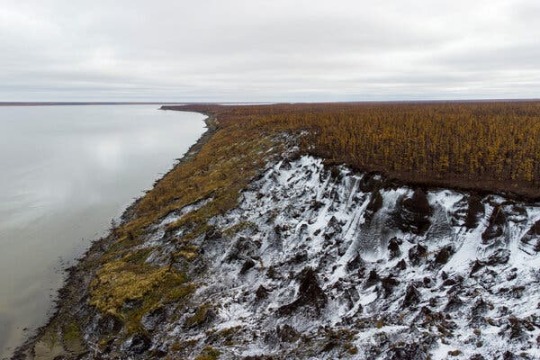
Melting permafrost near the Kolyma River southwest of the town of Chersky in the Russian Far East in 2021.Credit...Maxim Shemetov/Reuters
Another researcher in the study, Dr. Philipp Schiffer of the Institute for Zoology at the University of Cologne, said the more relevant application of the findings “is that in times of global warming we can learn a lot about adaptation to extreme environmental conditions from these organisms, informing conservation strategies and protecting ecosystems from collapsing.”
The Siberian permafrost has long offered the scientific community a window into the organisms of the distant past. Ancient viruses, mummified bodies and a suite of microscopic creatures have been resurrected from the ice over the years.
Amid the Covid pandemic, some have expressed concerns about unearthing ancient microorganisms, fearing that doing so could have deadly consequences for mankind.
Dr. Kurzchalia conceded that, theoretically, such a thing was possible, though he emphasized that the study of these organisms is conducted in sterile, lab-controlled settings.
A more prudent concern, in Dr. Kurzchalia’s view, is the threat of global warming significantly thawing the permafrost in Siberia. In that case, there would be no control over what is reintroduced to the world.
Though the ancient worms in the study died, that outcome was not unexpected given their life cycle, Dr. Kurzchalia said.
“Sleeping Beauty, when she came out, she didn’t live another 300 years,” he said.
1 note
·
View note
Text
By Orlando Mayorquin
At a time when the mighty woolly mammoth roamed the Earth, some 46,000 years ago, a minuscule pair of roundworms became encased in the Siberian permafrost.
Millennia later, the worms, thawed out of the ice, would wriggle again, and demonstrate to scientists that life could be paused — almost indefinitely.
The discovery, published this week in the peer-reviewed journal PLOS Genetics, offers new insight into how the worms, also known as nematodes, can survive in extreme conditions for extraordinarily long periods of time, in this case tens of thousands of years.
In 2018, Anastasia Shatilovich, a scientist from the Institute of Physicochemical and Biological Problems in Soil Science RAS in Russia, thawed two female worms from a fossilized burrow dug by gophers in the Arctic.
The worms, which were buried approximately 130 feet in the permafrost, were revived simply by putting them in water, according to a news release from the Max Planck Institute of Molecular Cell Biology and Genetics in Germany.
Called Panagrolaimus kolymaensis, after the Kolyma River in Russia, where they were found, the worms were sent to Germany for further study. The creatures, which have a life span measured in days, died after reproducing several generations in the lab, researchers said.
Using radiocarbon dating, researchers determined the specimens were frozen between 45,839 and 47,769 years ago, during the late Pleistocene.
The roughly millimeter-long worms were able to resist extreme low temperatures by entering a dormant state called cryptobiosis, a process researchers at the institute have been trying to understand.
No nematodes had been known to achieve such a dormant state for thousands of years at a time, Teymuras Kurzchalia, a professor emeritus at the institute who was involved in the study, said on Saturday.
“The major take-home message or summary of this discovery is that it is, in principle, possible to stop life for more or less an indefinite time and then restart it,” Dr. Kurzchalia said.
Researchers identified key genes in the nematode that allow it to achieve the cryptobiotic state. The same genes were found in a contemporary nematode called Caenorhabditis elegans, which can also achieve cryptobiosis.
“This led us, for instance, to understand that they cannot survive without a specific sugar called trehalose,” Dr. Kurzchalia said. “Without this sugar, they just die.”
While there are no clear practical applications for a deep understanding of cryptobiosis, that should not be a reason to stop the research, Dr. Kurzchalia said.
The discovery of semiconductors, or of the double helix structure of DNA, he said, took decades to yield a practical use, but ultimately turned out to be revolutionary.
“That’s the interest of science,” he said. “You end somewhere you didn’t presume.”
Cryptobiosis could, perhaps one day, be engineered by humans, he added.

Melting permafrost near the Kolyma River southwest of the town of Chersky in the Russian Far East in 2021.Credit...Maxim Shemetov/Reuters
Another researcher in the study, Dr. Philipp Schiffer of the Institute for Zoology at the University of Cologne, said the more relevant application of the findings “is that in times of global warming we can learn a lot about adaptation to extreme environmental conditions from these organisms, informing conservation strategies and protecting ecosystems from collapsing.”
The Siberian permafrost has long offered the scientific community a window into the organisms of the distant past. Ancient viruses, mummified bodies and a suite of microscopic creatures have been resurrected from the ice over the years.
Amid the Covid pandemic, some have expressed concerns about unearthing ancient microorganisms, fearing that doing so could have deadly consequences for mankind.
Dr. Kurzchalia conceded that, theoretically, such a thing was possible, though he emphasized that the study of these organisms is conducted in sterile, lab-controlled settings.
A more prudent concern, in Dr. Kurzchalia’s view, is the threat of global warming significantly thawing the permafrost in Siberia. In that case, there would be no control over what is reintroduced to the world.
Though the ancient worms in the study died, that outcome was not unexpected given their life cycle, Dr. Kurzchalia said.
“Sleeping Beauty, when she came out, she didn’t live another 300 years,” he said.
0 notes
Text
Photo by | Few landscapes feel as vast as Monument Valley, with its towers cast...
Photo by | Few landscapes feel as vast as Monument Valley, with its towers cast…
Photo by @chrisburkard | Few landscapes feel as vast as Monument Valley, with its towers casting ancient shadows over you. The scale here is so large, yet tiny organisms made up of algae and fungi live in the ground and create cryptobiotic soil, giving uncommon value to an already spectacular land. Source

View On WordPress
0 notes
Note
OK so.
First thing to note about polar and high-altitude environments is that, from a physiological standpoint, they are very difficult places to live. Creatures which live there are going to be one of two things: Evaders or Endurers.
Evaders are generally small animals that make use of behavioural strategies to avoid the harsh conditions (which, in both habitats, includes below-freezing temperatures, low humidity, lack of food, and - at high altitudes, or when there's snow on the ground - dangerous levels of UV radiation. They're going to do this by exploiting microclimates within their habitat - mostly burrows (hard to dig in frozen soils, but tunnels under the snow are both significantly warmer and significantly more humid than the environment above) or rock crevices (especially in alpine habitats, where erosion creates many ideal hiding places). Evaders are going to time their behaviours to coincide with periods of lower environmental stress - e.g. hibernate during the winter and move around during the summer, or only leave their burrows at daytime when they can warm up in the morning sunshine. Another category of evaders are migratory species which live and feed in the polar regions in the summer, and run away to more temperate climes during the winter. These animals can be larger, since they don't need to exploit microclimates when conditions are bad - they can just leave. Being big is also good for travelling since you can store more energy as fat reserves and cover more ground. Most animals in extreme environments are going to be evaders, just given the relative complexity of adaptation involved.
Endurers, on the other hand, don't migrate and are too big to hide in burrows or rock crevices, so they just tank the environmental damage incurred by the cold temperatures, low humidity, and lack of food. These tend to be large animals that can't effectively hide in burrows or crevices, and which are forced to face the elements head-on. Think muskox, etc. These animals must have specific adaptations to weather the cold - namely, endothermy. Looking at the distribution of life on earth today, the only animals which have any kind of significant presence in extremely cold environments are endotherms - lizards, frogs, salamanders, snakes, etc. all reach limits of their ranges much further south than mammals and birds. Polar endotherms must have additional ways of keeping warm, including thick insulation (blubber or fur), round bodies with few extremities (which are vulnerable to frostbite), and a complex system to warm incoming air so it doesn't freeze the lungs.
In the carboniferous, true endothermy is going to be rare (if it exists at all) and thus very few, if any, animals are going to be endurers. You might get some giant amphibians in high-latitude temperate swamps with similar adaptations to large pelagic fish like Tuna, but that's about it unless you find a clade that can swing both endothermy and insulation. The vast majority of polar animals are going to be evaders. Maybe some primitive synapsids or flying insects will be able to make the annual migration; more likely, the small reptiles, amphibians, and arthropods are going to wait out the winter in burrows and tunnels. Look at modern temperate ectotherms as examples: wood frogs can freeze solid in winter, garter and rattlesnakes find deep holes to hide in until it warms up again in the summer. In the absolute worst of conditions, on the ice sheets themselves, you might find some cold-hardy arthropods (like springtails) grazing on bacterial or algal films (maybe overwintering as cryptobiotic eggs or cysts), but for the most part there's gonna be nothing.
what kinds of creatures do you think lived in the mountains and glacial biomes of the Carboniferous period?
I don't think, from the top of my head, that we have any extensive fossil record of such biomes from the carboniferous. We don't even understand much about the terrestrial ecosystems beyond the coal forests.
I think we have some stuff from polar regions but especially mountains are a horrible place if you want to be preserved as a fossil. Mountains are places where erosion happens, not deposition.
48 notes
·
View notes
Text
In loving memory of the Cryptobiotic Soil
Nothing happened to it, its just really facinating and i love thinking about it
#cat-fishy speaks#i stuck my feet out from my comfy blanket burrito and it looked like seal flippers#cryptobiotic soil#~💜just living soil things💜~
3 notes
·
View notes
Text
*picks up tourists by the back of their necks and swings them like ferrets* stay on the fucking trail
405 notes
·
View notes
Photo

Crunchy Soil If you ever go off-trail in the iconic deserts of the American Southwest, you might notice a distinct crunch when you step. It’s a very significant crunch—it’s the sound of a very important soil called cryptobiotic soil or biological soil crust. Like most soil, cryptobiotic soil has a few components but one of its most important is cyanobacteria. Cyanobacteria is a binding agent when it gets wet. Tiny little filaments from the bacteria extend and move around in the soil, locking soil and other particles in place. This is a huge help against soil erosion, since particles that otherwise would be washed away quite easily are now safely stuck in cyanobacteria’s sticky network. Cyanobacteria are also nitrogen “fixers”. Nitrogen is incredibly important for plant growth, but as it is in the atmosphere, it’s completely useless. Nitrogen must be converted from N2 to NH4+ or NO2. Cyanobacteria in soil crusts do a great job at that and provide needed nitrogen in a land of limited resources. Cryptobiotic soil is a very fragile resource, so if you ever hear that crunch or notice a black crusty top layer to the soil, it’s time to get back on the trail. It can take up to 7 years for a biological soil crust to regenerate after its been damaged. These soil crusts have suffered a lot at the hands of rogue hikers, mountain bikers, and ATV’s. Loss of soil crust can lead to increasing rates of soil erosion, which is devastating for desert ecosystems. -CM Photo credit: Canyonlands National Park http://bit.ly/1LK451i For more information: http://bit.ly/1HN3xH4 https://underc.nd.edu/assets/174593/fullsize/pecararo_2010.pdf
#Science#soil#desert#cyanobacteria#nitrogen#chemistry#erosion#crunch#cryptobiotic#biologic soil crust#the earth story
167 notes
·
View notes